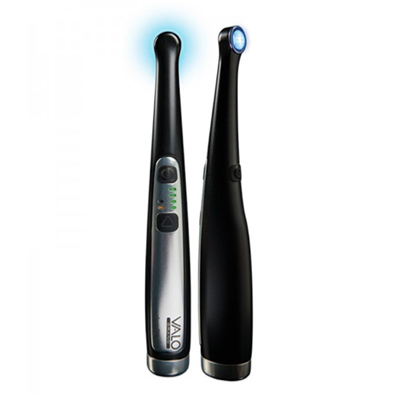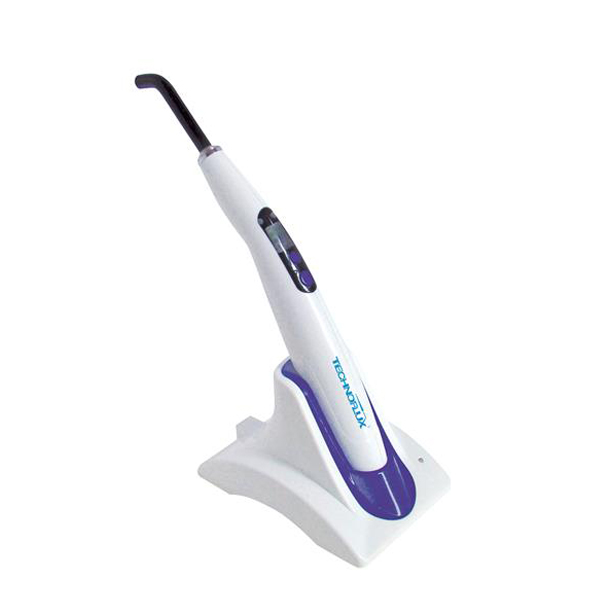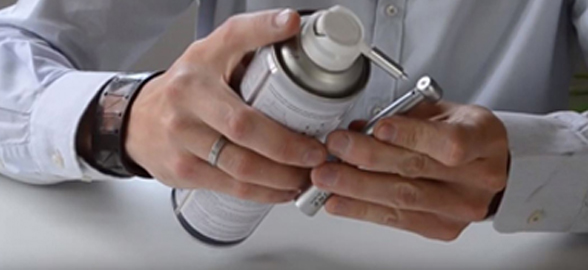Have you ever wondered why there is such a big price difference between one light curing lamp and another? The price is not only associated with the design and accessories of the curing lamp, but also with its functions and technical characteristics such as weight, wavelength and power output.
In today's article we will tell you about the types of lamps and their differences so that you can have optimal criteria when choosing one for your clinic, in addition, we will be showing you some models according to the price range. Are you ready? Let's get started!

Image Source: Ultradent
The function of light curing lamps is to polymerise light-sensitive resins in restorative processes, they can also be used to accelerate some whitening treatments. Adequate polymerisation is essential for long-lasting restorations and depends on:
- A light source with a certain power: According to Ivoclar Vivadent, at least 1,000 mW/cm2 is required to polymerise composites through a tooth structure in indirect restorations within 10 seconds. However, for direct restorations at least an output power of 400 mW/cm2
- is required.
- The exposure time.
- The quality of the light.
- Adequate wavelength: the wider the wavelength range, the better it will suit the wavelengths of each type of composite.
- The energy and heat given off.
In addition, as a basis for a correct selection of the light curing lamp you should also take into account:
- The polymerisation programmes it has.
- Wether it is wireless or corded and how long the battery takes to charge.
- Lightweight and ergonomic design.
What are the different types of curing lamps?
From Dentaltix we offer you some tips to help you when choosing the curing lamp that best suits your needs and we will recommend some of the best proposals currently available on the market.
Halogen curing lamp
They emerged more than 20 years ago and are incandescent lamps that produce infrared and consequently, heat. They are equipped with an optical filter so that the temperature does not increase excessively. Their disadvantage is that a large part of the energy produced is wasted and they generate a lot of heat.
Plasma arc lamps
This type of lamp produces light through an electrical discharge in the form of an arc between 2 tungsten electrodes. They have the advantage over halogen lamps of achieving a higher light intensity, generating a faster and deeper light curing. And their disadvantage? Their price is high and their wavelength is reduced,and therefore sometimes are not as effective or simply don't work with particular resins.
Laser polymerisation lamps
These lamps produce a wavelength that allows the polymerisation of composites but with a very high shrinkage, so this is a big disadvantage. In addition, they are very expensive.
The plasma arc and laser lamps, despite their high light output, ranging from 1400 to 2700 mW/cm2, did not succeed in the market because they generated too much heat and were expensive. The same is happening with halogen lamps, which are gradually being replaced by LED lamps (Light Emitting Diode) as they have some advantages compared to halogen lamps: they consume less energy, generate less heat and have a much longer service life.
LED curing lamps
These types of lamps are currently the most efficient: they allow you to convert electrical energy into light. You can achieve a 50% reduction in exposure time and heat production, ensuring a longer service life. In addition, they are silent, do not need a ventilation system and their consumption is low.
In fact, the latest generation LED lamps, both the cheapest and the most expensive ones, are characterised by ergonomics that benefit the user's comfort and by being smaller, lighter and easier to clean.
Below, we'll show you by price range LED curing lamps: Ready to shine in your practice? Let's go!
High-end LED curing light lamps:
These lamps cure in depth without damaging soft tissues thanks to their high power output.
Ultradent Valo Grand Cordless dental curing light
The Valo Grand light curing light has an elegant, ergonomic and aerodynamic design that allows it to reach all the surfaces to be polymerised without sacrificing patient comfort.
Features of the Ultradent Valo Grand Cordless dental polymerisation light:
- Lens 50% larger at 12 mm
- Light-emitting diode with multi-wavelength to emit high intensity light from 385-515 nm.
- Sleek, comfortable, aerodynamic design.
- High-power LEDs.
- Complete and uniform polymerisation.
- VALO Grand weight: 190 grams.

View Valo Grand LED curing light!
SDI Radii-Cal Light Curing Lamp
The LED curing lamp with excellent performance, in a small size with the highest power, curing even restorations.
Features of the Radii-Cal light curing lamp:
- High intensity
- Depth of cure: ensures optimal properties of the restorative material and increases the lifetime of the restoration.
- Without a fan.
- Wireless and easy to clean.
- With built-in radiometer.
- Weight: 144 grams

Medium/high-end LED curing lamp:
3M Elipar Deepcure Light Curing Lamp
Another interesting lamp with a mid-range price and high quality is the Elipar Deepcure, very suitable for clinics where the polymerisation lamp is to be used intensively.
Features of the Elipar Deepcure light curing lamp:
- LED for high curing depth
- Reliable and predictable even in the lower part of the mouth.
- It is lightweight which will help you in your treatments and not cause fatigue.
- Battery-operated
- Weight: 180 grams

View Elipar Deepcure Curing Lamp!
Mid-range LED Curing Lamp:
Technoflux Latte Light Curing Lamp:
LED light curing lamp characterised by emitting light with a fixed wavelength that solidifies the resin. It consists of a main unit with an elegant design.
Features of the Latte Light Curing Lamp:
- Composed 1200mw/cm2 high power LEDs, a main unit and an optimal fibre.
- With digital display to select the working time.
- With lithium battery.
- Can be recharged continuously.
- Weight: 178 grams

VIDEO: How to troubleshoot Curing Lamp Malfunctions?
It is very important to maintain our curing lights in good condition in order to prolong their useful life. Here are some recommendations that will help you to maintain the good care and use of the lamp and thus avoid many breakdowns:
- Do not overcharge the battery.
- Place the lamp correctly inside the base.
- One of the most common breakdowns is due to the optical fibre: avoid dropping it to avoid breakage. You must be very careful with this delicate part of the lamp.
Another important element is the radiometer; a device that measures the energy emitted by the light curing units. The use of this device in your clinic is necessary to control and ensure complete and safe polymerisation. The radiometer also alerts you to the need to change or repair the lamp. So it is important that the lamp has the radiometer in order to measure the power output.
If you want to know more criteria to choose your light curing lamp, visit our article How to choose a curing lamp for your dental practise? in which Alejandro de Rumar, tells us the technical and functional aspects to consider before purchasing it and in which we make many more recommendations.
Did you like this article? We encourage you to share it on social networks, on your website or blog to help spread the message. Do you have any doubts, did we forget something when we wrote it? We would be delighted to hear your comments and tell us all about what you think!





